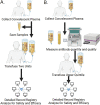COVID-19 Serology Data Provide Guidance for Future Deployments of Convalescent Plasma
- PMID: 37039667
- PMCID: PMC10294630
- DOI: 10.1128/mbio.00428-23
COVID-19 Serology Data Provide Guidance for Future Deployments of Convalescent Plasma
Abstract
Measurement of antibody content and function after a viral illness is important for diagnosis and selection of the best convalescent plasma (CP) units for passive immunization. Zhang et al. (mBio 14:e03523-22, 2013, https://doi.org/10.1128/mbio.03523-22) analyzed over 19,000 coronavirus disease 2019 (COVID-19) CP (CCP) samples from the early days of the COVID-19 pandemic and reported a moderately strong correlation between antibody amount and neutralizing titer. Strikingly, about one-third of the samples had little or no neutralizing activity. The results provide a detailed glimpse of the humoral immune response to severe acute respiratory syndrome coronavirus 2 (SARS-CoV-2) in immunologically naive humans and reveal major differences in the quality of CP units collected for passive therapy before antibody screening. Heterogeneity in CCP quality undoubtedly contributed to the variable therapeutic efficacy. Analysis of the COVID-19 serology data suggest that, for the next infectious disease emergency, the best approach after quick establishment of methods for robust antibody-level stratification would be to use CP units in the top quintile of antibody content and neutralizing capacity.
Keywords: COVID-19; SARS-CoV-2; convalescent plasma.
Conflict of interest statement
The authors declare no conflict of interest.
Figures

Comment on
- doi: 10.1128/mBio.03523-22
Similar articles
-
SARS-CoV-2 Infection of Rhesus Macaques Treated Early with Human COVID-19 Convalescent Plasma.Microbiol Spectr. 2021 Dec 22;9(3):e0139721. doi: 10.1128/Spectrum.01397-21. Epub 2021 Nov 24. Microbiol Spectr. 2021. PMID: 34817208 Free PMC article.
-
High-Throughput Neutralization and Serology Assays Reveal Correlated but Highly Variable Humoral Immune Responses in a Large Population of Individuals Infected with SARS-CoV-2 in the US between March and August 2020.mBio. 2023 Apr 25;14(2):e0352322. doi: 10.1128/mbio.03523-22. Epub 2023 Feb 14. mBio. 2023. PMID: 36786604 Free PMC article.
-
Simple prediction of COVID-19 convalescent plasma units with high levels of neutralization antibodies.Virol J. 2023 Mar 27;20(1):53. doi: 10.1186/s12985-023-02007-0. Virol J. 2023. PMID: 36973781 Free PMC article.
-
Passive Immunity for Coronavirus Disease 2019: A Commentary on Therapeutic Aspects Including Convalescent Plasma.Semin Thromb Hemost. 2020 Oct;46(7):796-803. doi: 10.1055/s-0040-1712157. Epub 2020 Jun 11. Semin Thromb Hemost. 2020. PMID: 32526774 Free PMC article. Review.
-
COVID 19 convalescent plasma: Is there still a place for CCP?Transfus Apher Sci. 2023 Apr;62(2):103680. doi: 10.1016/j.transci.2023.103680. Epub 2023 Feb 24. Transfus Apher Sci. 2023. PMID: 36870907 Free PMC article. Review.
Cited by
-
Estimates of actual and potential lives saved in the United States from the use of COVID-19 convalescent plasma.Proc Natl Acad Sci U S A. 2024 Oct 8;121(41):e2414957121. doi: 10.1073/pnas.2414957121. Epub 2024 Oct 1. Proc Natl Acad Sci U S A. 2024. PMID: 39352932 Free PMC article.
-
The role of convalescent plasma and hyperimmune immunoglobulins in the COVID-19 pandemic, including implications for future preparedness.Front Immunol. 2024 Sep 9;15:1448720. doi: 10.3389/fimmu.2024.1448720. eCollection 2024. Front Immunol. 2024. PMID: 39315108 Free PMC article. Review.
-
Topological data analysis and machine learning for COVID-19 detection in CT scan lung images.BMC Biomed Eng. 2025 Apr 2;7(1):4. doi: 10.1186/s42490-025-00089-1. BMC Biomed Eng. 2025. PMID: 40170109 Free PMC article.
References
-
- Senefeld JW, Johnson PW, Kunze KL, van Helmond N, Klassen SA, Wiggins CC, Bruno KA, Golafshar MA, Petersen MM, Buras MR, Klompas AM, Sexton MA, Soto JCD, Baker SE, Shepherd JRA, Verdun NC, Marks P, van Buskirk CM, Winters JL, Stubbs JR, Rea RF, Herasevich V, Whelan ER, Clayburn AJ, Larson KF, Ripoll JG, Andersen KJ, Vogt MNP, Dennis JJ, Regimbal RJ, Bauer PR, Blair JE, Wright K, Greenshields JT, Paneth NS, Fairweather D, Wright RS, Casadevall A, Carter RE, Joyner MJ. 2021. Access to and safety of COVID-19 convalescent plasma in the United States Expanded Access Program: a national registry study. PLoS Med 18:e1003872. doi:10.1371/journal.pmed.1003872. - DOI - PMC - PubMed
-
- Zhang S, Ma P, Orzechowski M, Lemmer A, Rzasa K, Bagnall J, Barkho S, Chen M, He L, Neitupski R, Tran V, Ackerman R, Gath E, Bond A, Frongillo G, Cleland T, Golas A, Gaca A, Fitzgerald M, Kelly K, Hazegh K, Dumont L, Hoffman C, Homer M, Marks P, Woolley A, Wong S, Gomez J, Livny J, Hung D. 2023. High-throughput neutralization and serology assays reveal correlated but highly variable humoral immune responses in a large population of individuals infected with SARS-CoV-2 in the US between March and August 2020. mBio 14:e03523-22. doi:10.1128/mbio.03523-22. - DOI - PMC - PubMed
Publication types
MeSH terms
Substances
Grants and funding
LinkOut - more resources
Full Text Sources
Medical
Miscellaneous

